Career Fire Fighter/EMT Dies in Ambulance Crash - Florida
This report was revised on July 14, 2006
 Death in the Line of Duty…A summary of a NIOSH fire fighter fatality investigation
Death in the Line of Duty…A summary of a NIOSH fire fighter fatality investigation
F2005-12 Date Released: May 12, 2006
SUMMARY
On August 23, 2004, a 22-year-old male career fire fighter/emergency medical technician (the victim) died after the ambulance in which he was riding crashed into a tree. The ambulance, with a patient on board, had proceeded through an intersection with lights and siren activated when the driver lost control after losing traction on a wet road. The victim, who was belted into the captain’s chair in the patient compartment, died on impact and was pronounced dead on scene. A paramedic who was also sitting in the rear of the ambulance was ejected and sustained serious injuries. He was transported to a local hospital via ambulance.
NIOSH investigators concluded that to minimize the risk of similar occurrences, emergency medical services (EMS) and fire departments should:
- replace worn tires as part of the apparatus maintenance program
- ensure that drivers operate emergency vehicles at speeds appropriate for the road conditions to prevent hydroplaning and loss of vehicle control
- ensure that drivers receive driver training at least twice a year
In addition, ambulance manufacturers, researchers and standard setting bodies should:
- continue to improve vehicle safety standards and designs for increased crash worthiness of ambulance patient compartments for occupant survivability
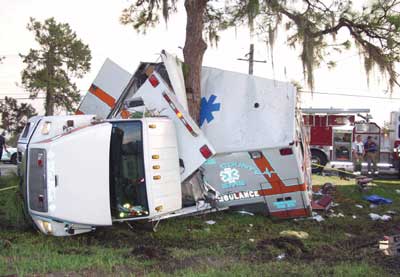
|
|
Photo courtesy of the Sheriff’s office.
|
INTRODUCTION
On August 23, 2004, a 22-year-old male career fire fighter/emergency medical technician (EMT) died after the ambulance in which he was riding reportedly hydroplaned, left the road, overturned, and crashed into a tree. On August 24, 2004, the U.S. Fire Administration (USFA) notified the National Institute for Occupational Safety and Health (NIOSH) of this fatality. On April 28, 2005, in response to a request from a local of the International Association of Fire Fighters (IAFF), a safety and occupational health specialist from the NIOSH Fire Fighter Fatality Investigation and Prevention Program performed an on-site investigation of the incident. The NIOSH investigator met with the Assistant Fire Chief, the Director of the county emergency medical services (EMS), the Deputy Fire Service Chief responsible for fire department safety and training, the Safety Manager from the County Risk Management Division, the Director of Fleet Management and several Fleet Management staff members, the union representative, an attorney for the fire department/County, and the medical supervisor/training coordinator for EMS. The NIOSH investigator interviewed the driver of the ambulance and the paramedic who was riding in the patient compartment with the victim. The NIOSH investigator reviewed the EMS division’s and fire department’s standard operating procedures (SOPs), training records of the victim and the driver, and the death certificate. The county Sheriff’s traffic crash report was also reviewed. The Chief of the Fatality Investigations Team also contacted the fire department and union for additional information. This was the fire department’s first workplace fatality involving an EMS division vehicle.
Department/Training:
This combination, county-wide fire department had been in service for approximately 30+ years, and employs approximately 250 career and 100 volunteer fire fighters in 31 stations. It serves about 300,000 people in an area of approximately 1,900 square miles. The victim had 3 years experience as a fire fighter/EMT, all with this county fire department.
This county government operates a Department of Public Safety (DPS). EMS and Fire are two divisions within the DPS. The driver of the EMS vehicle was employed by the county EMS division, and had been driving for the EMS division for more than 3 years at the time of the incident. According to the fire department, the EMS division routinely supports the fire department’s operations – including at fire suppression operations– and the fire department also supports the EMS division. It was noted during the investigation that the two different divisions have separate and distinct driver training requirements and maintenance policies for the vehicles. This investigation focused on the EMS divisions’ policies and training.
The driver reportedly spends approximately 80% of the time driving and the remainder of the time in the patient compartment. In 2000, prior to being hired, the driver successfully completed an emergency vehicle operations course (EVOC). After being hired in 2001, she completed a defensive driving course provided by the EMS division during which her driving skills were evaluated and approved by EMS division personnel. The defensive driving course included evasive maneuvers, driving through cones, turning, switching lanes, and backing. In accordance with the standard operating procedure Vehicles and Vehicle Operations,1 as a probationary employee, the operator completed six months of supervised driving documented by a supervising authority. The EMS division’s standard operating procedure also required emergency vehicle operators to successfully complete a departmental refresher course every five years. The State requires a Class “D” license with an “E” endorsement to drive emergency vehicles; the driver met this requirement. The driver was familiar with the area and this vehicle having operated it for more than six months.
Weather/road/intersection:
During a six week period prior to this incident, the County had experienced three hurricanes and unstable weather, and the EMS division and fire department’s employees were required to work long shifts under adverse conditions. At the time of the crash, the ambient temperature was 78° F. It was partly cloudy, wet and rainy (it was reported that rain had stopped prior to the incident). The road involved in the incident was a two-lane asphalt highway with left and right turn lanes and paved shoulders at an intersection. It was relatively flat and straight in the area of the incident. The intersection was controlled by an overhead traffic signal which, according to the sheriff’s report, appeared to be functioning properly at the time of the incident. The posted speed limit was 50 mph.
Apparatus/Maintenance:
The county EMS Division’s vehicle was a model year 2000 Type I (cover photo) ambulance with a gross vehicle weight rating of 20,000 pounds. Overall vehicle length was 298 inches. It was purchased new from the manufacturer. The EMS Division’s policy was to perform vehicle maintenance every 2,500 miles using a preventive maintenance checklist.2 The most recent maintenance performed on the incident vehicle occurred on July 26 through July 28, 2004. This maintenance did not include tire replacement. The mileage of the vehicle at the time of this maintenance was 184,647. The mileage at the time of the incident was noted to be 193,980. According to the vehicle maintenance personnel interviewed, the state does not require routine vehicle inspection certification.
Tires/Wheels:
The tires mounted on the vehicle, particularly the rear tires, showed signs of excessive wear and “wear bars,” or “tread indicators,” were visible (Photo 1). It is the EMS divisions’ policy to change tires as needed at intervals throughout the life of the ambulance. The EMS divisions’ maintenance records documented that the rear tires were replaced on February 18, 2004 at 162,542 miles. The Sheriff’s report3 documented different make and model tires than were identified on the EMS division’s maintenance records.
INVESTIGATION
On August 23, 2004, at approximately 1726 hours, the ambulance, with lights and siren activated, was heading west on a state roadway transporting a patient to the hospital. The driver stated that as she approached the intersection, she had scanned the intersection and then moved into the left (westbound) turn lane because of traffic congestion. After she cleared the intersection she traveled in the left turn lane for oncoming (eastbound) traffic due to continued traffic backup in the straight lane. Approximately 300 feet west of the intersection, as she was attempting to move into the straight (westbound) lane, the rear tires of the ambulance began skidding and the ambulance began to slide sideways and clockwise as the driver lost control. The vehicle continued to rotate clockwise and slid across the westbound straight lane. It then left the roadway and traveled approximately 77 feet and rolled onto the driver’s side as the roof impacted a tree. The driver estimated her speed at the time of the incident to be 30-35 mph when she lost control. Due to the collision with the tree and the abrupt stop, the actual speed of the vehicle could not be determined. The longest skid mark was approximately 172 feet long. (Diagram 1)
The victim was sitting on the attendant’s seat (captain’s chair) with his seatbelt on, in the patient compartment, behind the driver. After the crash he was found sitting in the impact area between the tree and the passenger compartment, entangled with various metal structures and items within the compartment. He was pronounced dead on scene at 1826 hours.
The paramedic, who was sitting on the side bench-seat, was ejected upon impact. He received serious arm injuries that required hospitalization, surgery, and an extended period of time away from work. According to the paramedic and the driver, both the victim and the driver were wearing their seatbelts at the time of the crash. The paramedic was not restrained. The patient was restrained on the stretcher. The patient that was being transported and the paramedic were transferred to other ambulances and transported from the incident scene to a local hospital.
Cause of Death
The medical examiner listed the cause of death as blunt force head trauma.
RECOMMENDATIONS/DISCUSSIONS
Recommendation #1: EMS and fire departments should replace worn tires as part of the apparatus maintenance program
Discussion: Discussion: NFPA 15004 chapter 6.4 outlines the requirements for the inspection, maintenance, and repair of fire apparatus, and states that: “All fire apparatus shall be inspected at least weekly, within 24 hours after any use or repair, and prior to being placed in service or used for emergency purposes to identify and correct unsafe conditions.” Though NFPA 1500 is targeted specifically to fire departments, this standard provides good guidance for emergency medical services organizations who, dependent on the jurisdiction, may operate ambulances independently from fire departments. The EMS division did not inspect vehicles according to NFPA 1500, rather it scheduled its vehicles to be inspected every 2,500 miles. Chapter 6.4.4 further states that “the fire department shall establish a list of major defects to be utilized to evaluate when a vehicle shall be declared unsafe.” While there was a “brakes and tires” inspection section on the EMS Division’s checklist that includes “Inspect all tires for wear, punctures, cracks, etc.” there was no guidance to determine at what point tire wear was to be deemed unsafe or in need of replacement. In addition, there was no requirement to determine tread depth as an indicator for tire replacement as part of the checklist.
NFPA 19155 states that “as part of the maintenance program to ensure safe travel, tires should be inspected for advanced and unusual wear, which can reduce the ability of tread to grip the road in adverse conditions.” EMS and fire departments should visually check tires for uneven wear, looking for high and low areas or unusually smooth areas and check for signs of damage. NFPA 1915 chapter 2.1.4.2 states “The following defects and deficiencies of the chassis, axles, steering and suspension systems, drive line, wheels, and tires reduce the operational safety and performance of the fire apparatus and shall be considered when developing the out-of-service criteria:
- Tires that have cuts in the sidewall that penetrate to the cord
- Tires that are defective
- Tires that have a tread depth of 4/32 inch. (3.2 mm) or less on any steering axle or 2/32 inch. (1.6 mm) or less on any non-steering axle at any two adjacent major tread grooves anywhere on the tire.
If any of these conditions exist, appropriate action, including tire replacement, should be performed.”
According to the National Highway Traffic Safety Administration (NHTSA), “Tires have built-in tread wear indicators that let you know when it is time to replace your tires. These indicators are raised sections spaced intermittently in the bottom of the tread grooves. When they appear even with the outside of the tread, it is time to replace your tires.”6 The tires mounted on the vehicle involved in this incident showed evidence of excessive wear and had visible tread wear indicators (Photo 1). Actual measurements taken of the rear, non-steering tires with a tread-depth indicator during the NIOSH investigation identified the tires as having the following maximum tread depth:
- Left (driver’s side) rear outside tire: 4/32 inch
- Left (driver’s side) rear inner tire: 2/32 inch
Recommendation #2 : EMS and fire departments should ensure that drivers operate emergency vehicles at speeds appropriate for the conditions to prevent hydroplaning and loss of vehicle control
Discussion: A major function of tire tread is to allow water to flow through the tread and allow the tires to maintain contact with the surface of the road. If inadequate tire tread exists, the water will not be displaced and the tires may “hydroplane,” or rise up on top of the water layer. The result can be a loss of traction and control. How well traction will be maintained on a wet road depends on several factors, including vehicle speed, amount of water present, and the condition of the tires (if tires are under-inflated or have excessive tread wear.) According to NHTSA, under-inflated tires can lead to uneven tread wear, skidding, hydroplaning, and loss of control on wet surfaces.6 To avoid hydroplaning and loss of control, drivers should slow down by easing their foot off the accelerator, avoid hard braking or sharp turns, drive in the tracks of the vehicle in front of them, and increase following distance. Drivers should also routinely check for worn tires and should maintain tire pressure at recommended levels, avoiding under inflation. The tires on the ambulance showed evidence of excessive tread wear and the wear bars were visible on at least one rear tire (Photo 1). The driver of the incident vehicle stated that she was driving at approximately 30-35 mph and the roadway was wet. Vehicle speed could not be verified in this investigation.
Recommendation #3 : EMS and fire departments should ensure that drivers receive driver training at least twice a year
Discussion: Driver training should be provided to all driver/operators as often as necessary to meet the requirements of NFPA 14517 but not less than twice a year. This training should be documented and cover defensive driving techniques during emergency and non-emergency conditions. Additionally, if fire fighters work in these vehicles – which was the case in this incident and county, EMS and fire departments’ driver training should be in accordance with NFPA 1451, Standard for a Fire Service Vehicle Operations Training Program and NFPA 10028, Fire Apparatus Driver/Operator Professional Qualifications. During this training, each driver should operate the vehicle and perform tasks that the driver/operator is expected to encounter during operations under normal and adverse conditions to ensure the vehicle is safely operated in compliance with all applicable State and local laws. The county EMS division’s policy stated that emergency vehicle operators must successfully complete a refresher course every five years.
Recommendation #4 : Ambulance manufacturers, researchers, and standard setting bodies should continue to improve vehicle safety standards and designs for increased crash worthiness of ambulance patient compartments for occupant survivability
Discussion: The victim had been riding in the attendant’s seat, (captain’s chair), restrained by a lap belt. (Photo 2) Use of occupant restraint systems such as lap and shoulder belts have proven an effective intervention for protection from vehicle crash-related fatalities. However, as evidenced by the circumstances present during this incident, additional vehicle crash worthiness issues such as vehicle structural integrity may significantly impact occupant survivability The driver reported that the vehicle was traveling between 30 and 35 mph when vehicle control was lost. Investigators could not estimate the speed of the vehicle, or the collision speed or related forces. However, during the ambulance’s side impact with the tree, the forces were sufficient for the roof and street side of the patient compartment structure to collapse, and the curbside wall to separate from the floor. This structural failure allowed the unrestrained paramedic to be ejected and the victim to be crushed by the collapsing structure (Photo 3).
The Federal Motor Vehicle Safety Standards (FMVSS) address issues of structural integrity for passenger cars including side impact protection and provide acceleration parameters that can be used to evaluate the level of protection required.9 However, structural standards of FMVSS may not apply to ambulances which are manufactured as incomplete vehicles by the automotive industry and are then equipped with patient compartments by ambulance manufacturers. Ambulance standards such as the Federal Specification for the Star-of-Life Ambulance, KKK-A-1822E and the American Society for Testing and Materials (ASTM) F-2020 Standard Practice for Design, Construction, and Procurement of Emergency Medical Services Systems Ambulances address structural integrity for the patient compartment in general terms but do not specify a level of side impact protection related to dynamic parameters such as acceleration.10, 11 Also, ambulances are not required to be dynamically tested as complete vehicles. Increased structural standards and designs could improve patient compartment structural integrity and allow for the implementation of other crash-related injury interventions. These might include improvements to the compartment layout to minimize the movement of patient care providers which would allow better utilization of occupant restraints and the application of energy absorbing padding on bulkhead surfaces to minimize energy transfer to occupants during crashes. Further protection could be provided through the use of improved seating locations and designs, compartmentalization of seating locations and application of air bag technology.
CHANGES INCORPORATED BY THE DEPARTMENT
Since this incident, the county EMS division instituted additional Emergency Vehicle Operators Course (EVOC) training. This training reportedly includes classroom as well as behind-the-wheel training.
REFERENCES
- EMS Division and Fire Department’s standard operating procedure Vehicles and Vehicle Operations
- EMS Divisions’ Vehicle Maintenance Checklist
- County Sheriff’s Traffic Fatality Investigation Report. Incident Number 2004-143807. 11/02/2004.
- NFPA [2002]. NFPA 1500: Standard on fire department occupational safety and health programs. Quincy, MA: National Fire Protection Association.
- NFPA [2000]. NFPA 1915: Standard for fire apparatus preventive maintenance program. Quincy, MA: National Fire Protection Association.
- NHTSA [2005]. Tire Safety Everything Rides on it (checklist)external icon. [http://www.nhtsa.gov/Vehicle+Safety/Tires]
Date accessed 05/17/2006. (Link updated 1/16/2013) - NFPA [2002]. NFPA 1451: Standard for a fire service vehicle operations training program. Quincy, MA: National Fire Protection Association.
- NFPA [2003]. NFPA 1002: Standard on fire apparatus driver/operator professional qualifications. Quincy, MA: National Fire Protection Association.
- NHTSA [2005] 49 CFR 571: Federal Motor Vehicle Safety Standards (FMVSS) Code of Federal Regulations, U.S. Government Printing Office, Office of Federal Register, December 2005.
- GSA [2002]. Federal Specification for the Star-of-Life Ambulance, KKK-A-1822E, General Services Administration, Federal Supply Service, GSA Automotive, Washington, DC, June 1, 2002.
- ASTM [2000]. Standard Practice for Design, Construction, and Procurement of Emergency Medical Services Systems (EMSS) Ambulances, American Society for Testing and Materials (ASTM), 100 Barr Harbor Drive, West Conshohocken PA, June 2000.
INVESTIGATOR INFORMATION
This investigation was conducted and initial report drafted by Linda Frederick, Safety and Occupational Health Specialist, and written in final form by Robert E. Koedam, Chief, Fatality Investigations Team, Fire Fighter Fatality Investigation and Prevention Program, Division of Safety Research, NIOSH. Paul Moore, Safety Engineer and Project Officer for the NIOSH Ambulance Crash Survivability Improvement Project authored recommendation #4 of this report.
DIAGRAM AND Photographs
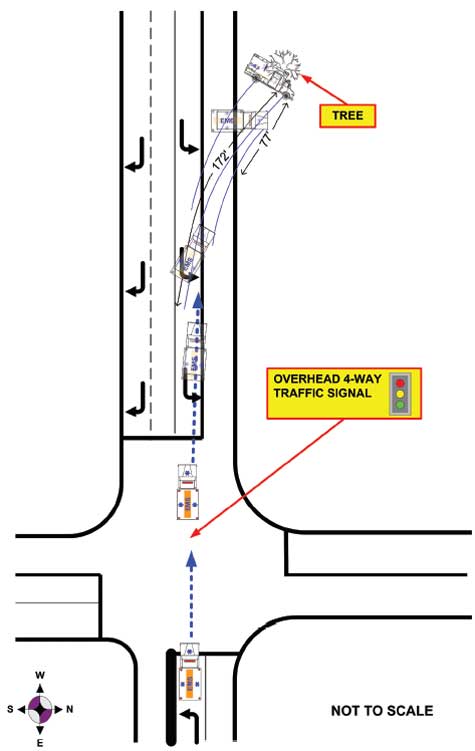
|
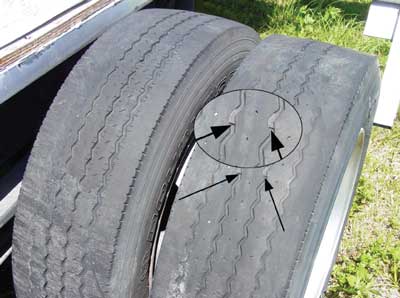
|
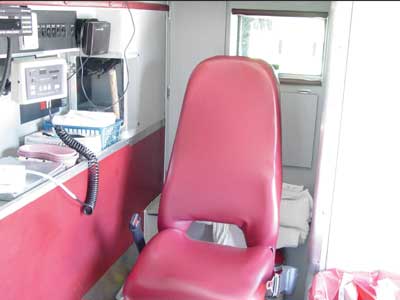
|
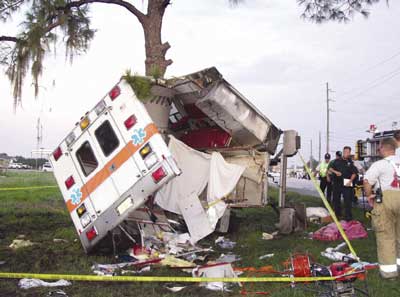
|
|
Photo 3. Patient compartment of ambulance after crash,
showing the separation of curbside wall and roof. (Photo courtesy of the County Sheriff’s office) |
This page was last updated on 07/14/06.
